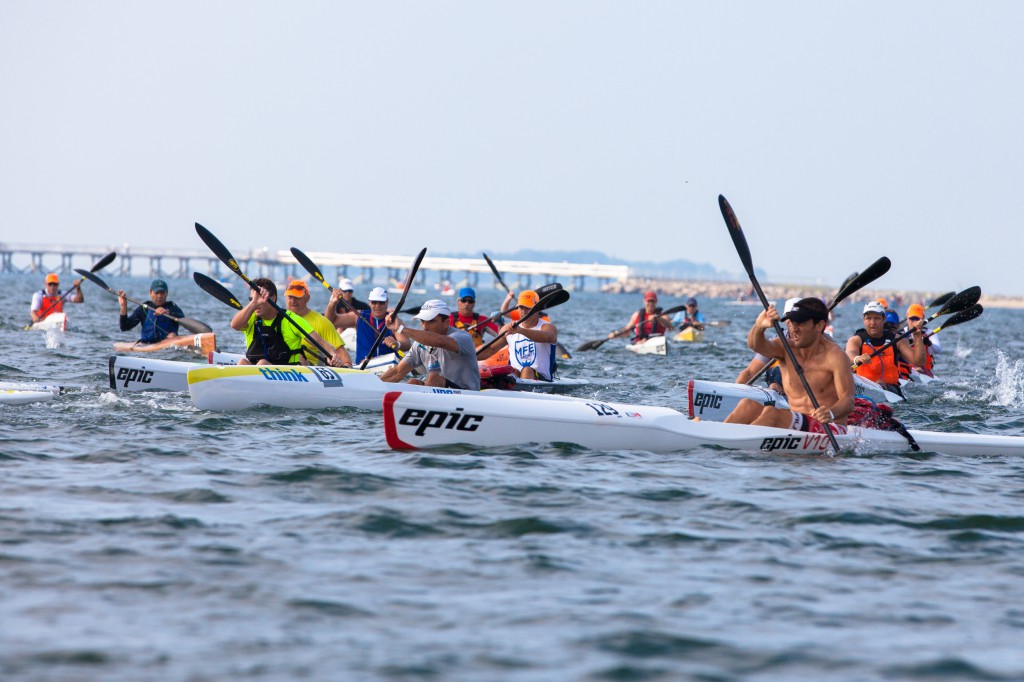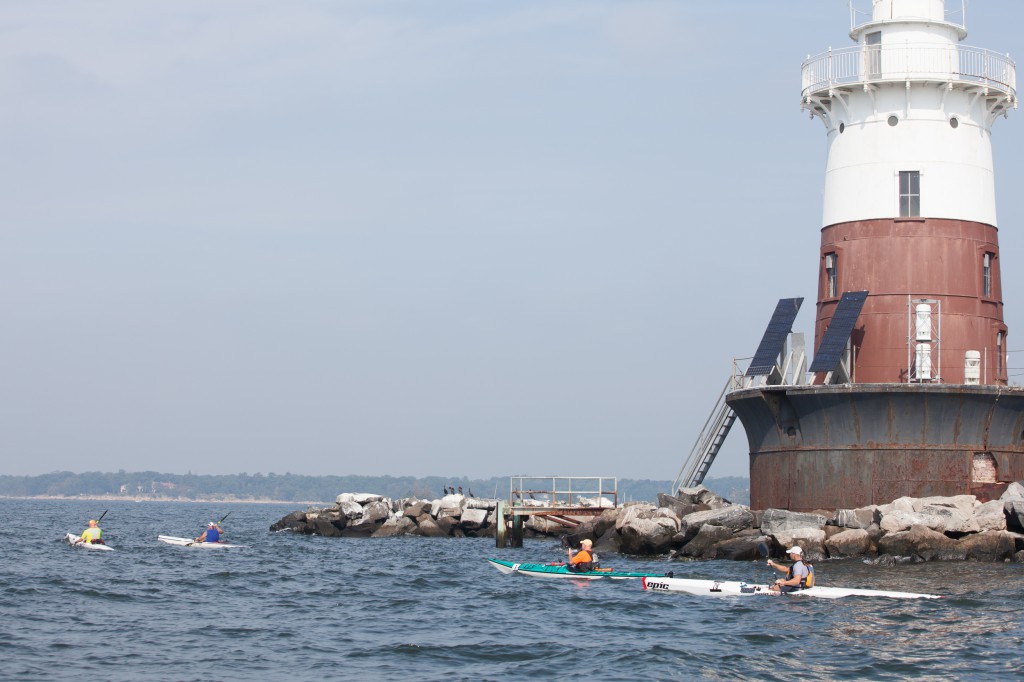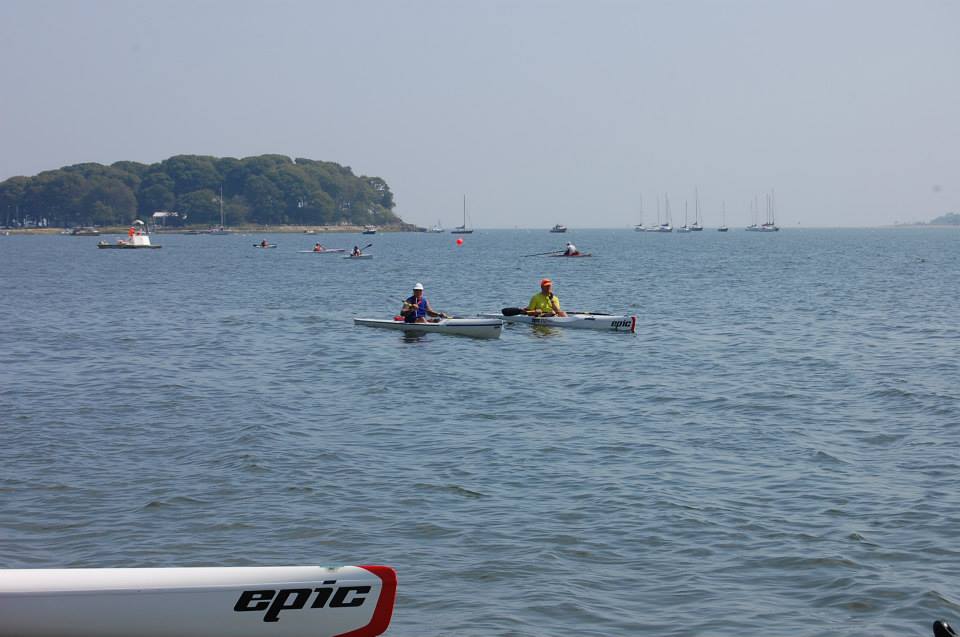Last year at this race, Dan and Steve and I had started out together and then Dan and I had clashed our paddles together, Dan had dumped, Steve had briefly stopped to see if he was ok, and so my victory over them was tainted. I was determined not to let that happen again. I was going to beat them fair and square. Last year’s first and second place winners had stayed home, so our only other rival was Alan from Ithaca, the guy in the sprint boat who, at Armond Basset this year, had started off with Jim and blown up, and I’d passed him about 5 or 6 kilometers into it. I was hoping he’d do the same at this race.
Unlike last year’s Erie Canal Regatta, I was paddling my V10 Sport. It’s certainly lighter than my Think Legend, but the Legend is longer and narrower and possibly a little faster on flat water. I meant to do some side by side time trialling to determine which was faster, but I got busy preparing for Lighthouse to Lighthouse and never put in any time in the Legend. And when I did paddle the Legend, I dropped it on the dock and put a crack in it. So it’s off getting fixed, so like it or not, I was in the V10 Sport, paddling against two guys in V12s and one guy in an ICF sprint boat.
Unlike last year, we started upstream. As expected, Alan took off and opened a large gap. Dan said “just paddle smooth”, as per our game plan. Steve hung on Dan’s stern wash and contributed nothing while Dan and I swapped leads, being extremely careful not to clash paddles. We both picked up a leaf or two, but were able to bounce them off. We weren’t really gaining on Alan, but after the first kilometer I don’t think we were losing much either.
As we got close to the first turn, it looked like Alan wasn’t going to turn – we yelled to him and he apparently heard, because he turned around the “dolphin” (a term for those wooden pilings in the water that apparently I’m the only person who knows it) in the opposite direction (ccw) than we were set up for (cw), but he had enough of a lead that it didn’t cause a conflict. As we turned, I could see we’d completely dropped Steve – he was a dozen or more boat lengths behind. And we were hammering. Or rather I was hammering and Dan was hanging on. His turns in front were getting shorter and at one point he called out his heart rate at 165 while mine was 155. But I didn’t slack off because I really wanted to catch Alan. We did a few sub-5-minute kilometers and I could tell Dan wasn’t going to be able to hang on. I asked him if he had one more pull in him and he pulled for a few minutes, but then he dropped back onto my wake. The nice thing to do at that point would have been to slow down enough that Dan could catch his breath without slowing down too much so that we got caught. But I had the fire in my blood and my sights on that sprint boat, and it was getting closer and closer. And at about the 6.5 kilometer mark, Dan dropped off my wake and I was on my own.
As we reached the downstream marker bouy for the turn upriver, I was a about a boat length behind. Then he did a better job at turning, and so opened the gap up to three boat lengths. I clawed my way back, but just as I got into his wake, I got a leaf on my bow. Now a leaf in the bow is a constant hazard in the canal, especially in the fall, and it’s a very bad thing. A leaf on the can cost you a half a kilometer per hour at worst. Get a bunch, and it can be a full kilometer per hour. Get one on your rudder and it’s twice as bad, but thanks to Todd’s weed guard I haven’t had a problem with leaves on my rudder in a few weeks. Sometimes you can bounce the boat to shake off a leaf, sometimes you can knock them off by deliberately hitting a floating stick, and sometimes a boat wake will knock them off, but sometimes the only way to get them off is to backpaddle, which is not something you want to do in a race. Evidently this was one of those times. I tried numerous bounces, and we did hit a boat wake or two, but that leaf stayed stubbornly on my bow. And every time I left Alan’s wake to try to pass him, it felt like I’d opened a parachute. So I just stayed tucked into his stern wash. His speed kept going up and down – if his intention had been to drop me, it nearly worked. But I had seen similar variations in his speed when I’d been chasing him down river – it would seem like I wasn’t making any ground for a few minutes, and then I’d be catching him for a few minutes, and then he’d be back up around the same speed as me and so on. I found out afterwards that he doesn’t have a GPS and he’s just not very good at pacing himself when there’s nobody around him.
The problem with staying in his wake is that he was going straight up the middle of the canal – on my own, I would have been tucked in closer to the edges where the current isn’t as strong, and there might have been opportunities to find a floating twig or something to knock that damn leaf off. But it wasn’t to be – even when a boat came in the opposite direction, instead of moving closer into shore, he went out to the other side of the canal to let the boat by. And unlike many people you see paddling ICF boats, he didn’t get thrown off his stroke by the boat wakes, so my other hope, that I’d be able to pull past him, didn’t happen either.
I stuck in his wake up until the town of Fairport, but I knew that eventually I’d have to make some sort of move to pass him. At the Parker Street bridge I tried to pull out, but the leaf caused the brakes to come on, so I pulled back in. Then approaching the lift bridge I realized I was running out of time so I pulled out. And it was awful – I just didn’t have anything left. Instead of pulling up onto his side wake and challenging him for the win, I ended up losing a boat length or two. He got a well deserved win, and I got a pretty satisfactory second place. But I can’t help but think that without that leaf, I might have been able to do it.
Last year, on a slightly different, slightly longer course, but a possibly faster boat, I’d averaged 10.7km/hr or 5:36 min/km, and this year, in what was objectively the slowest boat of the top 4 finishers, I averaged 11.2km/hr or 5:21 min/km. And that’s something to be happy with.



